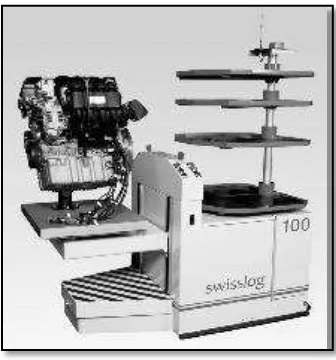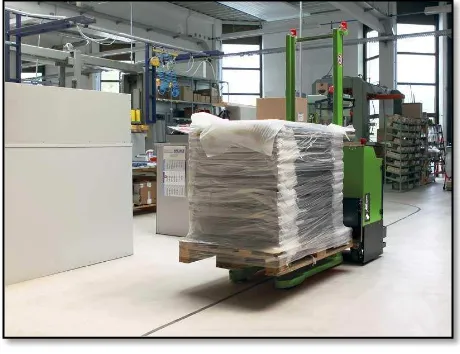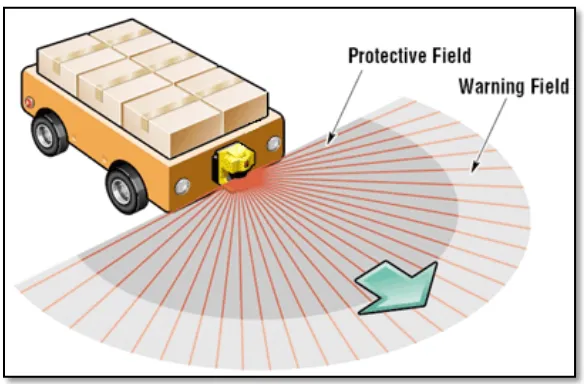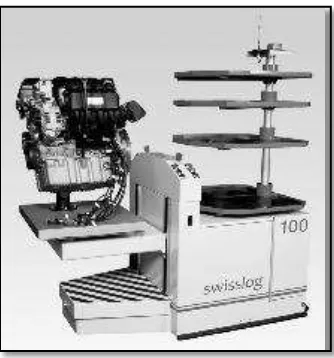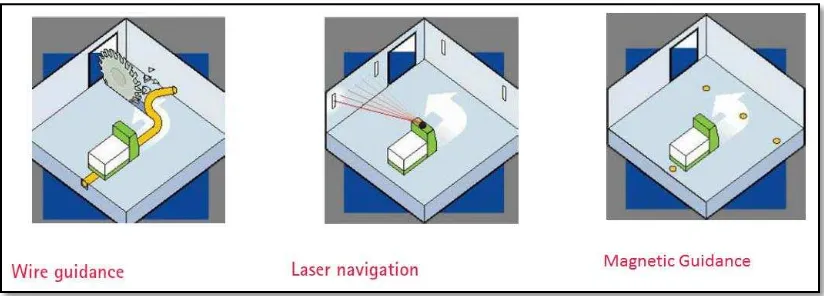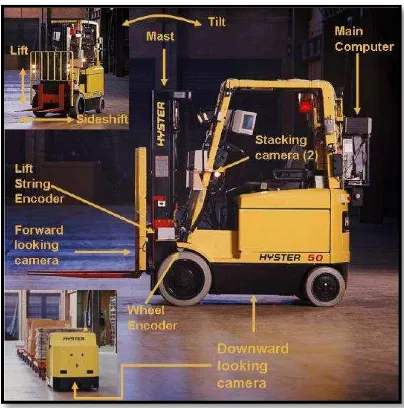UNIVERSITI TEKNIKAL MALAYSIA MELAKA
DEVELOPMENT OF AUTOMATED-GUIDED VEHICLE FOR
300KG TROLLEY TOWING APPLICATION
This report submitted in accordance with requirement of the Universiti Teknikal Malaysia Melaka (UTeM) for the Bachelor Degree of Manufacturing Engineering
(Robotics and Automation) (Hons.)
by
FADZIL BIN CHE MAN B051010017
880528-02-5643
i
ABSTRACT
ii
DEDICATION
iii
ACKNOWLEDGEMENT
vi
CHAPTER 5: RESULT & DISCUSSION
5.1 AGV Testing 40
5.1.1 Sizing Tape Detection 40 5.1.2 Achieve of the Path 41
5.2 Result 42
5.2.1 Sizing Tape Detection 42 5.2.2 Achieve of the Path 46
5.3 Discussion 48
5.3.1 Sizing Tape Detection 48 5.3.2 Achieve a Path 48
CHAPTER 6: CONCLUSION& FUTURE WORK
6.1 Conclusion 49
6.2 Future Work 50
REFERENCES 51
ix
LIST OF TABLES
3.1 Gantt chart 19
3.2 Bill of material 21
5.1 Result for 1 inch width 42
5.2 Result for 2 inch width 43
5.3 Result for 3 inch width 44
5.4 Result for 4 inch width 45
x
LIST OF ABBREVIATIONS, SYMBOLS AND
NOMENCLATURE
AGV - Automatic Guided Vehicle DC - Direct Current
JIRA - Japanese Industrial Robot Association LED - Light-emitting Diode
PIC - Programmable Interface Controller RIA - Robotics Institute of America RISC - Reduce Instruction Set Computer RPM - Rotation per Minutes
1
CHAPTER 1
INTRODUCTION
1.1 Background
2
Figure 1.1: The mobile robot (Roland Siegwart and Illah R. Nourbakhsh, 2004).
Usually in a warehouse, men are the main to maintain productivity. With the help of smart computer, AGV are safe and easy to operate. A precision change allows it to navigate with precision in tight spaces. The AGV is very flexible as a result of remote in communication. Its ability to communicate with other autonomous vehicles provide in smooth operation and continuous coordination between vehicles delivering efficiency savings.
3
(a) AGV towing vehicles. (b) AGV unit load carriers.
(c) AGV forklift trucks.
Figure 1.2: AGV applications, (a) AGV towing vehicles, (b) AGV unit load carriers, and (c) AGV forklift trucks.
4
Figure 1.3: Obstacle Detection of Automated Guided Vehicle (AGV), (http://www.omron-ap.co.in).
1.2 Problem Statement
Currently, trolleys on production line especially in warehouse area are being pushed by workers irregular intervals. In fact workers lead to unproductive time and cost. Therefore AGV are used out to solve the problem situation.
1.3 Objective
The aim objectives of this project are: i. To investigate the AGV technology. ii. To develop the AGV.
5
1.4 Scope
6
CHAPTER 2
LITERATURE REVIEW
2.1
Introduction
7
Figure 2.1: The mobile robot sojourners that explore mars in summer 1997 (Siegwart and Nourbakhsh, 2004).
In the general terms the mobile robot can be defined as mobile systems equipped with sensors to interact with the external environment and navigate with it when trying to achieve several objectives. There are several mobile robots that can change their location through movements such as Automatic Guided Vehicles (AGV). Figure 2.2 shows an AVG that are used to transport a motor blocks from the assembly station to another (Roland Siegwart and Illah R. Nourbakhsh, 2004).
8
Refer to the American scientist and author Isaac Asimov wrote a novel that titled "Run-around" where the word "Robotics" was used for the first time in 1942. He tried to describe the technology of robots, and also to protect people and limit the impact that the robot will result in a future society.
Hence, Asimov defined three laws:
i. A robot may not injure a human, or allow a human being to be injured.
ii. A robot must follow any order given by a human being that does not conflict with the first law.
iii. A robot must protect itself unless such protection conflicts with the first or second laws.
According to the Robot Institute of America (1979), a robot is defined as a reprogrammable, multifunctional manipulator designed to move material, parts, tools, or specialized devices through various programmed motions for the performance of a variety of tasks. For the Japanese Industrial Robot Association (JIRA), robots are divided into the following six classes, which are:
Class 1: Manual handling device: a device with several degrees of freedom actuated by the operator;
Class 2: Fixed sequence robot: handling device which performs the successive stages of a task according to a predetermined, unchanging method, which is difficult to modify;
Class 3: Variable sequence robot: the same type of handling device as in class 2, but the stages can be modified easily;
9
Class 5: Numerical control robot: the human operator supplies the robot with a movement program rather than teaching it the task manually;
Class 6: Intelligent robot: a robot with means to understand its environment, and the ability to successfully complete a task despite changes in the surrounding conditions under which it is to be performed.
However, it is different with Robotics Institute of America (RIA) view. The only considers the machines which are at least in class 3 as robots. They define “robot is a re -programmable, multifunctional manipulator (or device) designed to move material, parts, tools, or specialized devices through variable programmed motions for the performance of a variety of tasks.
2.2 Application Of Mobile Robots
10
2.3 Research Study on AGV
Automated Guided Vehicle (AGV) to improve efficiency and reduce costs by helping to automate a manufacturing facility or warehouse. The first AGV was created by Berrett Electronics in 1953. AGV can tow objects behind them in trailers that they can autonomously attach. Trailers can be used to move raw materials or finished products. Objects can be placed on a set of motorized rollers (conveyor) and then refused to reverse them. Some AGVs use a forklift to lift objects for storage. AGV employed in virtually every industry, including, pulp, paper, metal, newspaper, and general manufacturing. It is also used in transporting a material such as food, linen or medicine in hospitals.
In addition to choosing the right vehicle for the right job, there are also choices to be made when it comes to AGV guidance, also referred to as navigation systems. Navigation systems can be closed path or open path. Bellow it a list part of AGV guidance. Figure 2.3 shows the picture example of navigation system.
11
2.3.1 Line Following
A line follower consists of an infrared light sensor and an infrared LED. It works by illuminating a surface with infrared light, the sensor then picks up the reflected infrared radiation and based on its intensity, determines the reflectivity of the surface in question. Light-colored surfaces will reflect more light than dark surfaces, resulting in their appearing brighter to the sensor. This allows the sensor to detect a dark line on a pale surface, or a pale line on a dark surface. Figure 2.4 shows the picture of line tracking navigation principle on the line follower robot.
12
2.3.2 Wire Guidance
Wire-guidance is the simplest form of navigation, designed for a set, predictable path. Torrens likens wire-guidance to a hound dog following a scent trail that has verifications along the way. An RF signal is transmitted from the wire that’s buried in a slot below the floor to a sensor under the vehicle. The sensor detects the signal and adjusts the position of the vehicle to keep it on the path. Because the slot must be cut into the floor, wire-guided systems are most commonly used in applications that require a high degree of accuracy on the path, like an AGV traveling back and forth between two workstations in a congested area (Lorie King Rogers, 2011).
2.3.3 Magnetic Guidance
13
sees what it sees and can evaluate its environment in real time,” explains Torrens. “It looks for the ability to go around obstacles and can change its mind in a moment’s notice.” (Lorie King Rogers, 2011). Figure above shows systems of navigate by vision guidance.
Figure 2.5: Structure in AGV system (Arkin, 1989).
